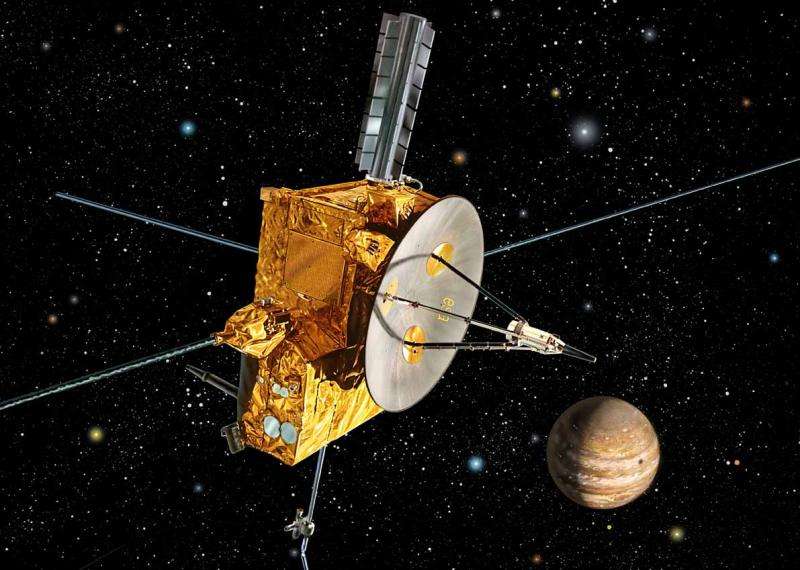Ulysses spacecraft at Jupiter encounter. Credit: ESA/Dave Hardy
(Phys.org)—In 1990, an important space probe was launched, tasked with the ambitious mission of orbiting the sun and scanning our star at all latitudes. However, the much-publicized mission was not solar research but the detection of tiny particles from interstellar space. This joint NASA/ESA mission, lasting 19 years, has revealed the properties of the particles originating from interstellar space and has provided new insights on these tiny cosmic visitors.
The researchers working on the project have recently published important scientific results regarding theUlysses mission and its findings. They extracted the most detailed information on mass, size, and flight direction of the interstellar dust using data from more than 900 particles examined by the spacecraft.
"The data from Ulysses that we have now evaluated for the first time in their entirety, are unique," said Harald Krüger, principal investigator of the Ulysses dust detector at the Max Planck Institute for Solar System Research in Göttingen, Germany.
The particles, dubbed "messengers from the depths of space," are constantly invading our solar system as the sun and planets move through the Milky Way galaxy. We are now passing through a giant cloud of interstellar matter, called the Local Interstellar Cloud, the source of these dust particles, which is about 30 light years in diameter. The so-called "stardust" is embedded in the local galactic cloud through which the sun is moving at a speed of 26 km/s. A single dust grain takes 20 years to traverse the solar system.
The interstellar dust particles, detected in situ for the first time in 1993 by the Ulysses spacecraft, are very valuable for scientists as they contain crucial information about our more distant cosmic neighbors. The new study confirmed earlier findings, according to which the interstellar dust always sweeps through our solar system in approximately the same direction. The research also revealed precise information about the size of these particles, showing that some are remarkably large, even several micrometers wide, while the majority of the dust particles have diameters ranging from 0.05 to 0.5 micrometers, about one hundredth the diameter of a human hair.
According to Veerle Sterken from the University of Stuttgart in Germany, who led the analysis with Krüger, Ulysses' observational position was optimal to analyze the interstellar dust. Ulysses is the only spacecraft so far that has left the orbital plane of the planets and has flown over the sun's poles. While interplanetary dust produced within our planetary system is concentrated in the orbital plane, interstellar dust can be measured well outside this plane. The unique orbit of the probe has also enabled studies of gamma-ray bursts that otherwise would not have been possible, and played a major role in discovering soft gamma repeaters, or "magnetars."
The study of the interstellar dust is important for understanding its role in forming celestial objects in the universe. "Stardust" can drive the mass loss when a star is nearing the end of its life, and plays a part in the early stages of star and planet formation. Astronomers estimate that approximately 4.6 billion years ago, the gravitational collapse of an interstellar cloud led to the formation of a protosolar disk, called the solar nebula, with a central condensation developing into our sun.
The observations and measurements of cosmic dust in different regions provide an important insight into the universe's recycling processes. Scientists try to obtain observational "snapshots" of the dust at different stages of its life and, over time, to create a complete movie of the universe's complicated recycling steps.
Ulysses helped to produce a complete movie of this process. The other missions, like Galileo and Cassini—as well as the mission Stardust, which in 2006 returned captured interstellar dust particles to Earth—are perceived by the researchers studying the topic as providing only snapshots of information. Now, the scientists endorse future ESA-led space missions to precisely investigate interstellar dust and help complete the big picture.
More information: Harald Krüger et al. SIXTEEN YEARS OF INTERSTELLAR DUST MEASUREMENTS IN THE SOLAR SYSTEM. I. MASS DISTRIBUTION AND GAS-TO-DUST MASS RATIO , The Astrophysical Journal (2015). DOI: 10.1088/0004-637X/812/2/139
Peter Strub et al. SIXTEEN YEARS OF INTERSTELLAR DUST MEASUREMENTS IN THE SOLAR SYSTEM. II. FLUCTUATIONS IN THE DUST FLOW FROM THE DATA , The Astrophysical Journal (2015). DOI: 10.1088/0004-637X/812/2/140
Veerle J. Sterken et al. SIXTEEN YEARS OF INTERSTELLAR DUST MEASUREMENTS IN THE SOLAR SYSTEM. III. SIMULATIONS AND DATA UNVEIL NEW INSIGHTS INTO LOCAL INTERSTELLAR DUST , The Astrophysical Journal (2015). DOI: 10.1088/0004-637X/812/2/141
Journal information: Astrophysical Journal
© 2015 Phys.org























